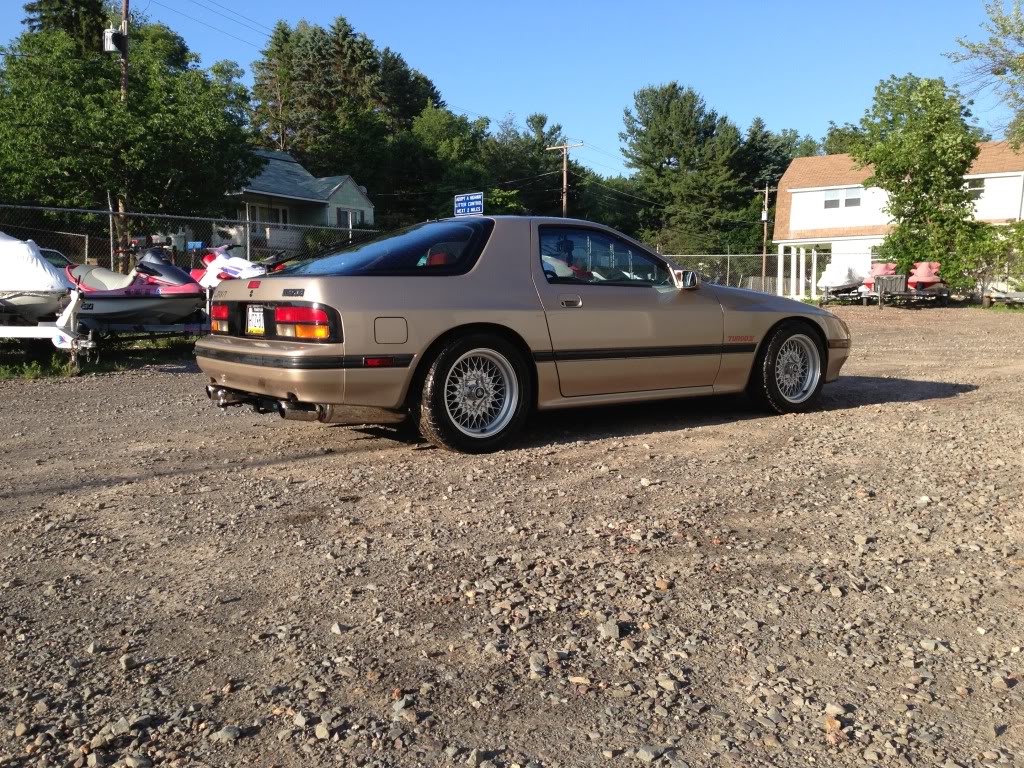How To: Cut Coils
#1
How To: Cut Coils
Now I know you guys say that cutting coils is for Honda Civics, is stupid, just buy coil overs for 1K, and blah blah blah. But, if done properly there is no reason that it can not be done.
My 87 tII came with Eibach springs and Tokico something or others. I was satisfied with the height of the front, but I felt the back should be about 1" lower, mostly for looks...and in theory should help body roll. My car may see the occasional autocross event, but 90% of the time it is my daily...so I am not interested in race car performance.
Before photo....a bit to much wheel gap for my liking.
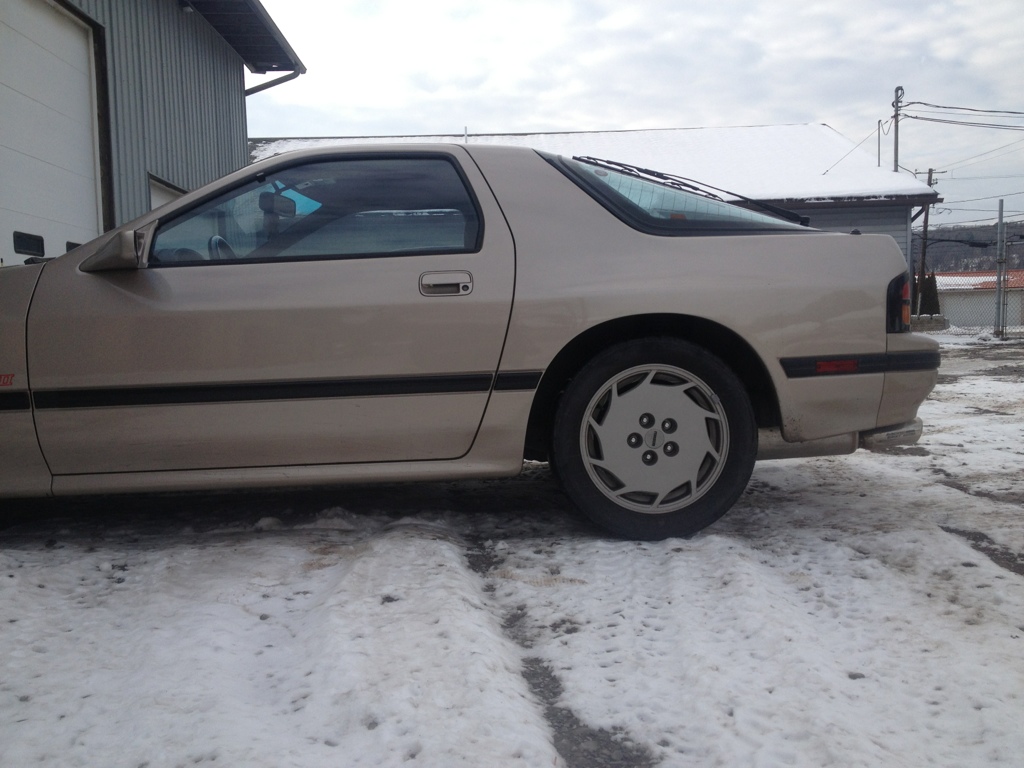
As you can see here the top 3 coils or so are basically dead coils, so trimming them off will yield little result in performance.
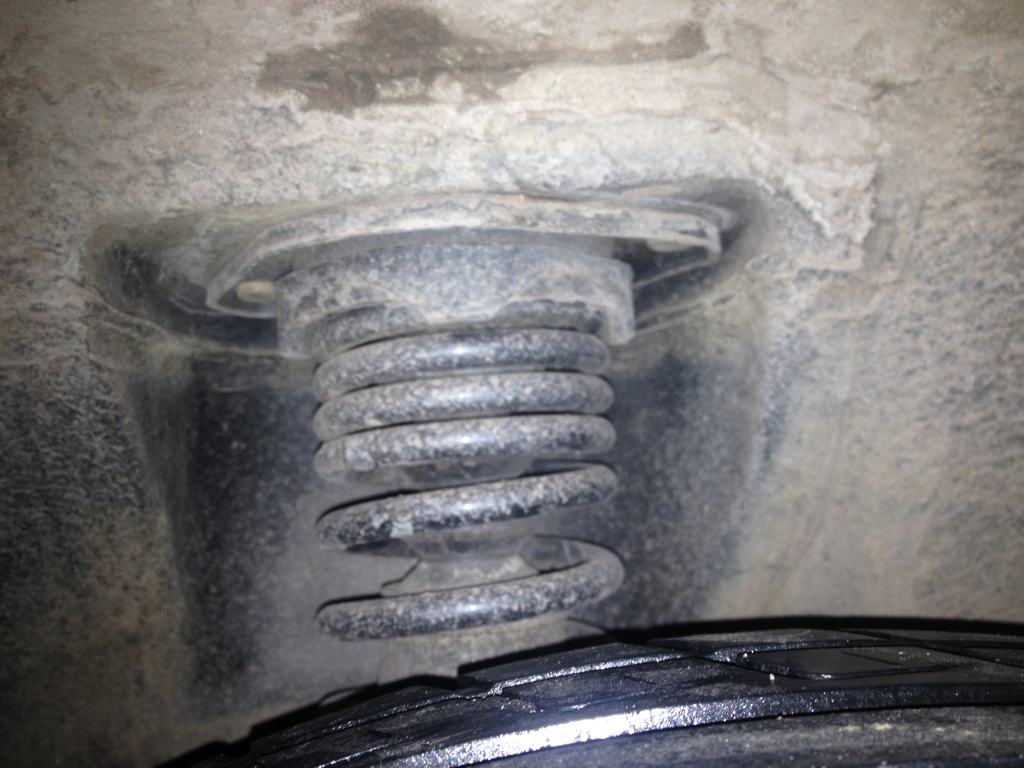
Eibach coil, I believe these lower the car 0.8" from stock
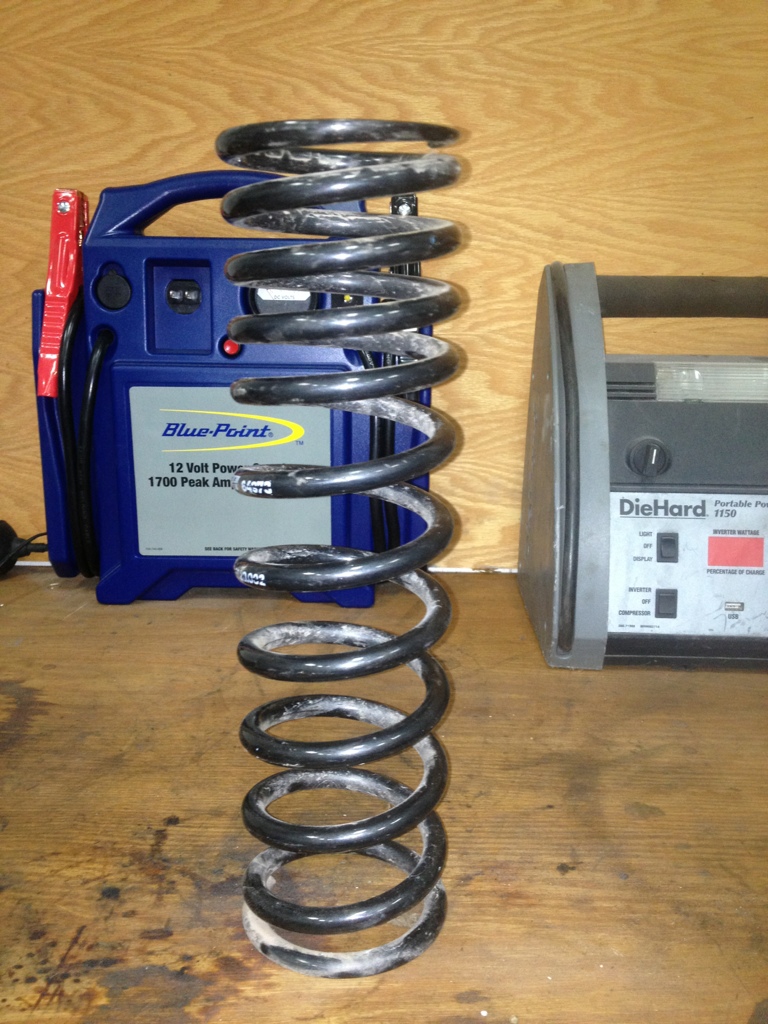
With a cutoff wheel I removed a full coil off the top of the spring (I was just making a complete guess as to how much it would lower the car haha).
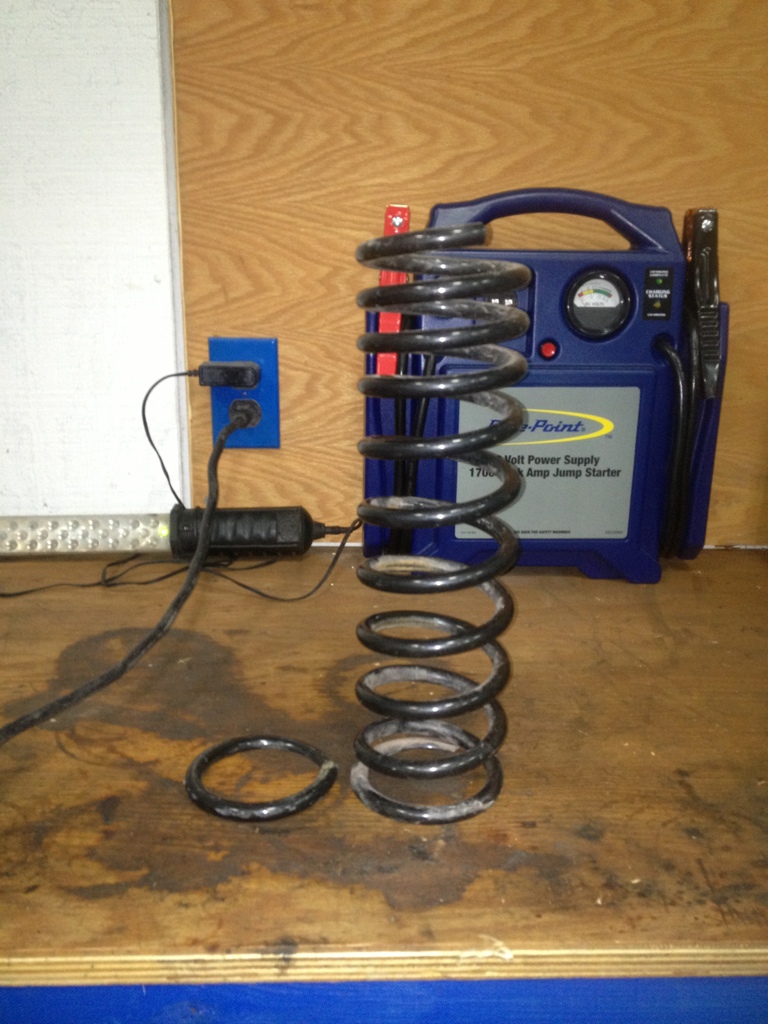
I then heated the coil about 3 inches from the end until it was red and bent it to be as flat as possible. I am sure someone will complain that this heat will hurt the spring, but keep in mind where it was heated has no effect performance.
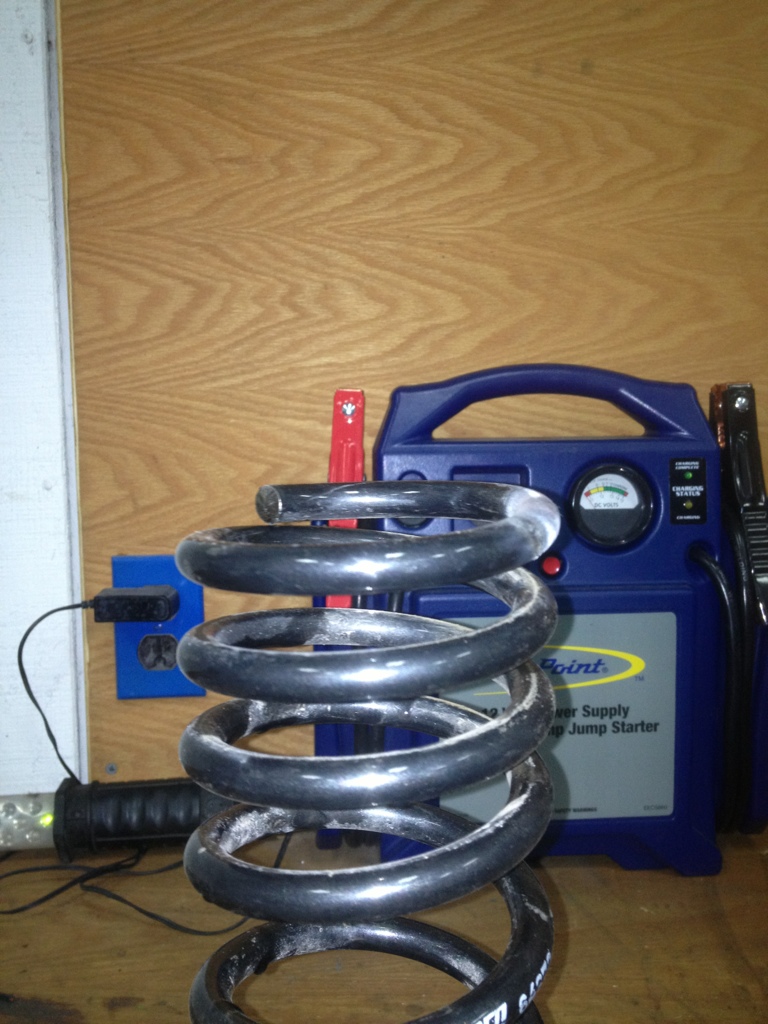
Then with a bench grinder, a level, and some time, I ground it flat, resembling a stock coil...I was probably 1/16" out but it is good enough for government work.
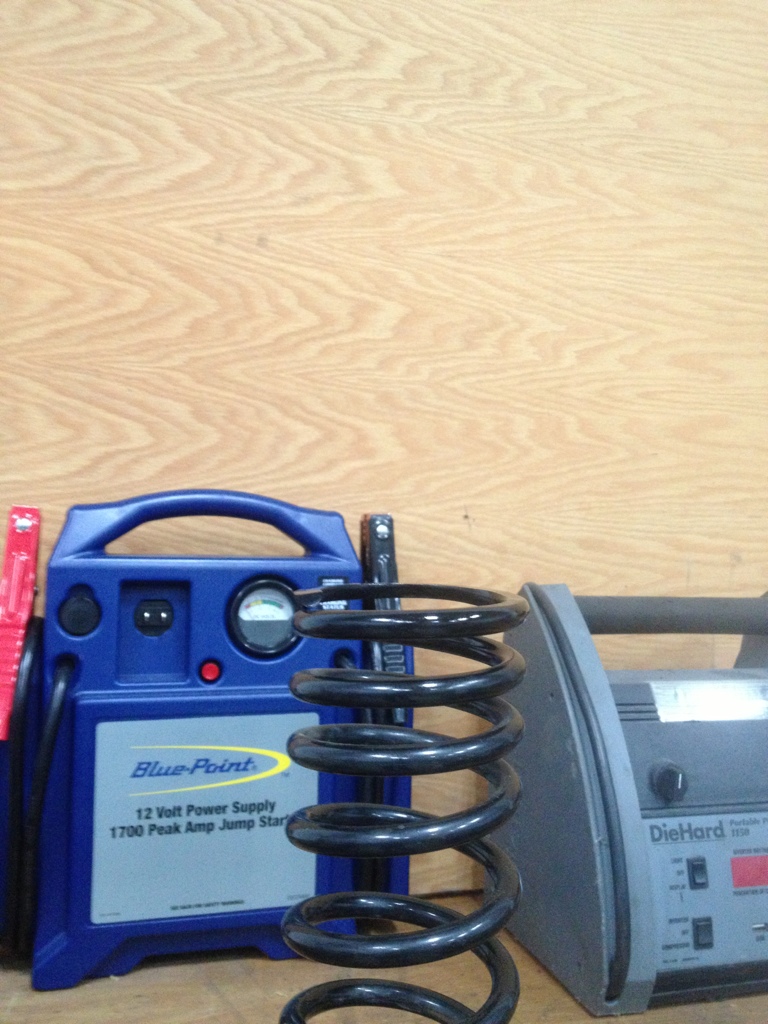
In the next two pictures you can see the before and after of fender height. Before was 26 7/16", after the cut it was 25 13/16" give or take. Yielding a bit over a half inch of lowering...not quite my goal, but it is winter time here in PA so I can always go more in the spring. These measurements were also taken before I drove the car allowing it to settle.

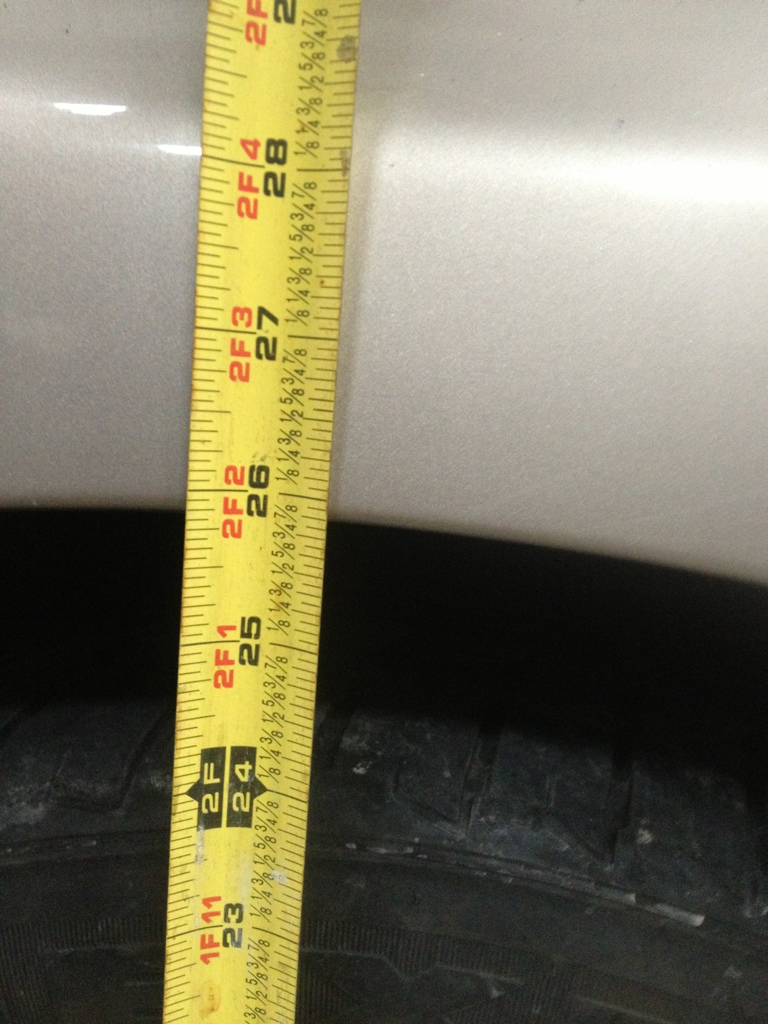
Here is an after shot of the car, better but not quite where I want it.
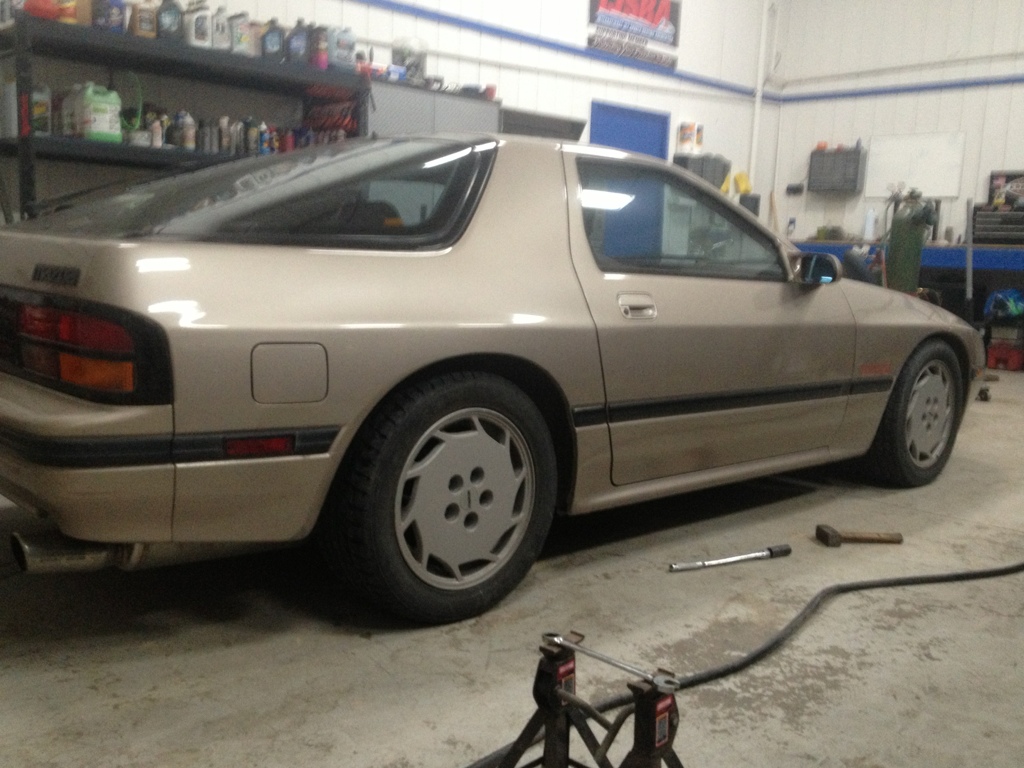
Drive-ability has not changed a bit, the process may have taken me 2 hours total with a lot of BSing in between. Happy Reading!
My 87 tII came with Eibach springs and Tokico something or others. I was satisfied with the height of the front, but I felt the back should be about 1" lower, mostly for looks...and in theory should help body roll. My car may see the occasional autocross event, but 90% of the time it is my daily...so I am not interested in race car performance.
Before photo....a bit to much wheel gap for my liking.

As you can see here the top 3 coils or so are basically dead coils, so trimming them off will yield little result in performance.

Eibach coil, I believe these lower the car 0.8" from stock

With a cutoff wheel I removed a full coil off the top of the spring (I was just making a complete guess as to how much it would lower the car haha).

I then heated the coil about 3 inches from the end until it was red and bent it to be as flat as possible. I am sure someone will complain that this heat will hurt the spring, but keep in mind where it was heated has no effect performance.

Then with a bench grinder, a level, and some time, I ground it flat, resembling a stock coil...I was probably 1/16" out but it is good enough for government work.

In the next two pictures you can see the before and after of fender height. Before was 26 7/16", after the cut it was 25 13/16" give or take. Yielding a bit over a half inch of lowering...not quite my goal, but it is winter time here in PA so I can always go more in the spring. These measurements were also taken before I drove the car allowing it to settle.


Here is an after shot of the car, better but not quite where I want it.

Drive-ability has not changed a bit, the process may have taken me 2 hours total with a lot of BSing in between. Happy Reading!
#4
You could do that... or you could do something that makes more sense. Just put this on top of your car to make it lower:

Cutting your springs is not just for honda owners, it's for people who don't understand spring rates and ride heights. Ever seen that really low car riding around that hits a bump then bounces around like you just dropped a 2x4? That's what you get. You CAN NOT "properly" cut springs.
You don't need to spend $1k on springs. I lowered mine with a set of tanabes for $150.
Cutting your springs is not just for honda owners, it's for people who don't understand spring rates and ride heights. Ever seen that really low car riding around that hits a bump then bounces around like you just dropped a 2x4? That's what you get. You CAN NOT "properly" cut springs.
You don't need to spend $1k on springs. I lowered mine with a set of tanabes for $150.
#5
Every time someone talks about cutting springs that's all I hear. "You can't do it!" Bullshit! You can do it, its just that 99% of the people do it wrong or for the wrong reasons.
Is it ideal in most situations? No. Sometimes though, depending on the spring perch design it doesn't matter. Example: FB rear end, lower spring perch.
This situation where the coil is in full bind at ride height it is just there taking up space. The active coils end about 1/4 to 1/2 coil passed the last point of coils touching.
The area he heated up didn't spread into the active coils enough to affect the temper. If it was an active coil it will cause problems and there is no way to know what rate you will end up with and that area will probably fail sooner than later. Result; sagging spring.
I can spend $1000 on aftermarket springs and still ride around on the bumpstops! It isn't a cut spring issue, its a poor design or set up issue.
Do some math and in certain cases YOU CAN cut springs properly. Did you know you can also shrink springs too? I once took a set of stock FIAT X1/9 springs and shrank them 3/4". All you have to do is compress the entire spring to coil bind and throw it in your oven at 500F for about an hour. Let it cool and it's free height will be shorter. I got the spring rate I wanted by taking some chunks of a spare coil and used a bunch of hose clamps to hold them in between the coils, effectively removing that coil from the equation. I raced the car for a couple years with that set up. There wasn't always an 'aftermarket' for some cars to just order parts from, hell there wasn't even the internet when i was running the FIAT...
Is it ideal in most situations? No. Sometimes though, depending on the spring perch design it doesn't matter. Example: FB rear end, lower spring perch.
This situation where the coil is in full bind at ride height it is just there taking up space. The active coils end about 1/4 to 1/2 coil passed the last point of coils touching.
The area he heated up didn't spread into the active coils enough to affect the temper. If it was an active coil it will cause problems and there is no way to know what rate you will end up with and that area will probably fail sooner than later. Result; sagging spring.
I can spend $1000 on aftermarket springs and still ride around on the bumpstops! It isn't a cut spring issue, its a poor design or set up issue.
Do some math and in certain cases YOU CAN cut springs properly. Did you know you can also shrink springs too? I once took a set of stock FIAT X1/9 springs and shrank them 3/4". All you have to do is compress the entire spring to coil bind and throw it in your oven at 500F for about an hour. Let it cool and it's free height will be shorter. I got the spring rate I wanted by taking some chunks of a spare coil and used a bunch of hose clamps to hold them in between the coils, effectively removing that coil from the equation. I raced the car for a couple years with that set up. There wasn't always an 'aftermarket' for some cars to just order parts from, hell there wasn't even the internet when i was running the FIAT...
#7
The point is that you're not going to get each spring at the same height. Cutting the tightly compressed coils removes part of the higher spring rate area. Suspension coils are designed with variable spring rates. The area he showed wasn't even fully compressed. It still had travel, and still did its job. Heating springs only anneals them, thus making them weaker. Unless you are some sort of metallurgist, nobody out there heating their springs to make them lower really understands the sort of effects its taking on the steel.
While we're at it, let's all weld washers to the bathtub area of S4 rotors so they'll be higher compression. It makes just as much sense.
While we're at it, let's all weld washers to the bathtub area of S4 rotors so they'll be higher compression. It makes just as much sense.
Trending Topics
#8
I guess I'm more of a metalurgist than you then. He didn't heat a live coil. The area he cut with the tighter coils is a low rate area. It looks like he had to jack the car up a little to get that shot and that is what caused the gaps. I may be wrong on that point, there may be some small gaps at ride height, BUT, that area will be the first to go to bind with any kind of load.
There are variable rate springs, yes, but the more wire(more coils) the softer the spring with everything else equal. The part of the spring with fewer coils is stiffer.
I still put him in the 1% that did it right.
There are variable rate springs, yes, but the more wire(more coils) the softer the spring with everything else equal. The part of the spring with fewer coils is stiffer.
I still put him in the 1% that did it right.
#9
If you're for ghetto-modding your car, that's fine. It's not a good idea at all, and it can not be done correctly. Period. There is no "right and wrong" way to do this, it's all wrong. It's like doing the throttle body mod. Everyone wants to do it because it's a "free power mod". Well, there will never be an end to the "car won't idle right" threads until people realize that removing the BAC, thermowax, dashpots, etc. off the throttle body does absolutely nothing for performance and it only adds to cold start and idling issues. Just like cutting and heating springs will lead to one side sagging, uneven tire wear, shitty ride, etc. I can see there's never going to be an end to the argument. 

#10

Stick to what you know but don't believe everything you think

I've got a spring rate tester, shock dyno and 2 flow benches. You? I've also got Young's modulus and Poisson's ratio on my side too. I never said you can heat a spring just anywhere, the OP didn't heat the spring to get it to lower the car. Only to make it match the perch profile.
I'll agree with the TB mod being crap. IIRC the last time I tested a stock one it flowed over 550cfm. No where near a choke point in the intake.
#11
Interesting discussion guys.
I don't know enough to comment on the validity of the mod but will say that IF you're going to cut a spring, Robert's approach gives a fine looking result.
I don't know enough to comment on the validity of the mod but will say that IF you're going to cut a spring, Robert's approach gives a fine looking result.
#12
I have to side with AGreen here. Heating the metal in this spring will affect how it responds to shock. How it cooled from that state will also affect that (i.e., the rate at which it cooled, which will determine whether it was annealed or hardened).
While this may not bring any ill results in this particular case (it seems as though, in my life, whenever I warn someone against something, nothing bad ever happens to them, which makes me look somewhat foolish, so good luck ) agressive heating directly, through flame, induction, etc... or indirectly by grinding, should be avoided in high-stress areas like the spring.
) agressive heating directly, through flame, induction, etc... or indirectly by grinding, should be avoided in high-stress areas like the spring.
My personal opinion would be to avoid this particular method of lowering, and spend the somewhat lowly price of $150 for something with a warranty, higher build quality (think: how many miles do your springs already have? my stockers already sag to the right, I'm certainly not going to use them...), and only requires a spring compressor and a 3/8 socket set.
my $.02
While this may not bring any ill results in this particular case (it seems as though, in my life, whenever I warn someone against something, nothing bad ever happens to them, which makes me look somewhat foolish, so good luck
 ) agressive heating directly, through flame, induction, etc... or indirectly by grinding, should be avoided in high-stress areas like the spring.
) agressive heating directly, through flame, induction, etc... or indirectly by grinding, should be avoided in high-stress areas like the spring.My personal opinion would be to avoid this particular method of lowering, and spend the somewhat lowly price of $150 for something with a warranty, higher build quality (think: how many miles do your springs already have? my stockers already sag to the right, I'm certainly not going to use them...), and only requires a spring compressor and a 3/8 socket set.
my $.02
#13
He didn't heat the spring in an area that matters! The whole spring isn't affected if you heat a couple inches on one end. The live coils, the ones that are free to move, are what matters. Heat them and you're asking for trouble. That is what most people do and it is what has lead to all this mis-information about modifying a spring.
Not heating the spring is best but if your perch is flat you need to box the end of the spring. Many perches are designed to handle the end of a spring that isn't boxed and you CAN cut the spring to lower the car. Most people don't do the math to find out how much the spring rate will go up when they cut the spring. They think, "I'll just cut a coil off" What happens then is the free height of the spring is much shorter and it lowers the car. The problem is the rate didn't go up enough to keep the car off the bump stops.
There IS a limit to how much you can take off a spring. It has to do with the amount of twist you ask the coil to do while it moves through its range of motion. If you try to make a soft spring stiff by removing free coils and still expect it to move the same amount you may reach its yeild point and it will fail. Example: 10" tall spring that has to cycle 3" in normal use, will be fine. Now cut the spring down to 7" tall and still ask it to cycle that same 3" and it will eventually fail to be a spring.
Its just math guys. Find a spring calculator online and play with the numbers.
Not heating the spring is best but if your perch is flat you need to box the end of the spring. Many perches are designed to handle the end of a spring that isn't boxed and you CAN cut the spring to lower the car. Most people don't do the math to find out how much the spring rate will go up when they cut the spring. They think, "I'll just cut a coil off" What happens then is the free height of the spring is much shorter and it lowers the car. The problem is the rate didn't go up enough to keep the car off the bump stops.
There IS a limit to how much you can take off a spring. It has to do with the amount of twist you ask the coil to do while it moves through its range of motion. If you try to make a soft spring stiff by removing free coils and still expect it to move the same amount you may reach its yeild point and it will fail. Example: 10" tall spring that has to cycle 3" in normal use, will be fine. Now cut the spring down to 7" tall and still ask it to cycle that same 3" and it will eventually fail to be a spring.
Its just math guys. Find a spring calculator online and play with the numbers.
#14
I guess I'm more of a metalurgist than you then. He didn't heat a live coil. The area he cut with the tighter coils is a low rate area. It looks like he had to jack the car up a little to get that shot and that is what caused the gaps. I may be wrong on that point, there may be some small gaps at ride height, BUT, that area will be the first to go to bind with any kind of load.
There are variable rate springs, yes, but the more wire(more coils) the softer the spring with everything else equal. The part of the spring with fewer coils is stiffer.
I still put him in the 1% that did it right.
There are variable rate springs, yes, but the more wire(more coils) the softer the spring with everything else equal. The part of the spring with fewer coils is stiffer.
I still put him in the 1% that did it right.
He didn't heat the spring in an area that matters! The whole spring isn't affected if you heat a couple inches on one end. The live coils, the ones that are free to move, are what matters. Heat them and you're asking for trouble. That is what most people do and it is what has lead to all this mis-information about modifying a spring.
Not heating the spring is best but if your perch is flat you need to box the end of the spring. Many perches are designed to handle the end of a spring that isn't boxed and you CAN cut the spring to lower the car. Most people don't do the math to find out how much the spring rate will go up when they cut the spring. They think, "I'll just cut a coil off" What happens then is the free height of the spring is much shorter and it lowers the car. The problem is the rate didn't go up enough to keep the car off the bump stops.
There IS a limit to how much you can take off a spring. It has to do with the amount of twist you ask the coil to do while it moves through its range of motion. If you try to make a soft spring stiff by removing free coils and still expect it to move the same amount you may reach its yeild point and it will fail. Example: 10" tall spring that has to cycle 3" in normal use, will be fine. Now cut the spring down to 7" tall and still ask it to cycle that same 3" and it will eventually fail to be a spring.
Its just math guys. Find a spring calculator online and play with the numbers.
Not heating the spring is best but if your perch is flat you need to box the end of the spring. Many perches are designed to handle the end of a spring that isn't boxed and you CAN cut the spring to lower the car. Most people don't do the math to find out how much the spring rate will go up when they cut the spring. They think, "I'll just cut a coil off" What happens then is the free height of the spring is much shorter and it lowers the car. The problem is the rate didn't go up enough to keep the car off the bump stops.
There IS a limit to how much you can take off a spring. It has to do with the amount of twist you ask the coil to do while it moves through its range of motion. If you try to make a soft spring stiff by removing free coils and still expect it to move the same amount you may reach its yeild point and it will fail. Example: 10" tall spring that has to cycle 3" in normal use, will be fine. Now cut the spring down to 7" tall and still ask it to cycle that same 3" and it will eventually fail to be a spring.
Its just math guys. Find a spring calculator online and play with the numbers.
For the guy who claims you will never get the springs the same height...how do you figure? A measuring tape, level, and a straight edge make magical measuring devices. Also it took me a long time to grind the spring as i was trying to keep the heat down as much as possible, If I had to cut the live coils for this project i would have left well enough alone.
I have about 100 miles on the car and it has settled in nicely. Both sides are even and my alignment is still good to go...
#15
[quote=jgrewe]
He didn't heat the spring in an area that matters!
[\quote]
If the spring were to crack here, would it matter. So yes, I feel like it does matter.
[quote=jgrewe]
The whole spring isn't affected if you heat a couple inches on one end. The live coils, the ones that are free to move, are what matters. Heat them and you're asking for trouble. That is what most people do and it is what has lead to all this mis-information about modifying a spring.
[\quote]
I disagree. Stress (not like fatigue or wear or tension, I'm talking about technical "stress", as in force/area) is being applied to that part of the spring, whether free to move or not. This stress is changing, as the load is moving to and from that corner of the car. Fluctuations in stress applied to a hardened or annealed surface will test it's strength, and could ultimately cause it to fail.
That's all true. I guess. If you're going to do this it's a good idea to take these things into account.
Quick calculator (Hooke's Law):
load = -(spring constant)*(distance stretched or compressed from normal)
For multiple spring constants in the same spring, you add the constants in the following format:
(1/new equivalent) = (1/constant one) + (1/constant two)
Anyways. That's my response. I hope it wasn't disrespectful, I just wanted to state what I knew.
He didn't heat the spring in an area that matters!
[\quote]
If the spring were to crack here, would it matter. So yes, I feel like it does matter.
[quote=jgrewe]
The whole spring isn't affected if you heat a couple inches on one end. The live coils, the ones that are free to move, are what matters. Heat them and you're asking for trouble. That is what most people do and it is what has lead to all this mis-information about modifying a spring.
[\quote]
I disagree. Stress (not like fatigue or wear or tension, I'm talking about technical "stress", as in force/area) is being applied to that part of the spring, whether free to move or not. This stress is changing, as the load is moving to and from that corner of the car. Fluctuations in stress applied to a hardened or annealed surface will test it's strength, and could ultimately cause it to fail.
Originally Posted by jgrewe
Not heating the spring is best but if your perch is flat you need to box the end of the spring. Many perches are designed to handle the end of a spring that isn't boxed and you CAN cut the spring to lower the car. Most people don't do the math to find out how much the spring rate will go up when they cut the spring. They think, "I'll just cut a coil off" What happens then is the free height of the spring is much shorter and it lowers the car. The problem is the rate didn't go up enough to keep the car off the bump stops.
Originally Posted by jgrewe
There IS a limit to how much you can take off a spring. It has to do with the amount of twist you ask the coil to do while it moves through its range of motion. If you try to make a soft spring stiff by removing free coils and still expect it to move the same amount you may reach its yeild point and it will fail. Example: 10" tall spring that has to cycle 3" in normal use, will be fine. Now cut the spring down to 7" tall and still ask it to cycle that same 3" and it will eventually fail to be a spring.
Its just math guys. Find a spring calculator online and play with the numbers.
Its just math guys. Find a spring calculator online and play with the numbers.
load = -(spring constant)*(distance stretched or compressed from normal)
For multiple spring constants in the same spring, you add the constants in the following format:
(1/new equivalent) = (1/constant one) + (1/constant two)
Anyways. That's my response. I hope it wasn't disrespectful, I just wanted to state what I knew.
Last edited by sft3303; 01-08-13 at 11:28 AM.
#16
I have to side with AGreen here. Heating the metal in this spring will affect how it responds to shock. How it cooled from that state will also affect that (i.e., the rate at which it cooled, which will determine whether it was annealed or hardened).
While this may not bring any ill results in this particular case (it seems as though, in my life, whenever I warn someone against something, nothing bad ever happens to them, which makes me look somewhat foolish, so good luck ) agressive heating directly, through flame, induction, etc... or indirectly by grinding, should be avoided in high-stress areas like the spring.
) agressive heating directly, through flame, induction, etc... or indirectly by grinding, should be avoided in high-stress areas like the spring.
My personal opinion would be to avoid this particular method of lowering, and spend the somewhat lowly price of $150 for something with a warranty, higher build quality (think: how many miles do your springs already have? my stockers already sag to the right, I'm certainly not going to use them...), and only requires a spring compressor and a 3/8 socket set.
my $.02
While this may not bring any ill results in this particular case (it seems as though, in my life, whenever I warn someone against something, nothing bad ever happens to them, which makes me look somewhat foolish, so good luck
 ) agressive heating directly, through flame, induction, etc... or indirectly by grinding, should be avoided in high-stress areas like the spring.
) agressive heating directly, through flame, induction, etc... or indirectly by grinding, should be avoided in high-stress areas like the spring.My personal opinion would be to avoid this particular method of lowering, and spend the somewhat lowly price of $150 for something with a warranty, higher build quality (think: how many miles do your springs already have? my stockers already sag to the right, I'm certainly not going to use them...), and only requires a spring compressor and a 3/8 socket set.
my $.02
Please show me lowering springs with a warranty for $150...The springs that are on my car are in fact high quality Eibach's with about 5K on them...I think the point you guys are missing on this particular application is that the place I heated is basically a SPACER.
#17
Nice job. Looks really good.
My .02 regarding changing the properties of the metal:
Heating the metal (and arbitrarily in this case, bending it) and then allowing it to cool slowly is basically annealing the spring metal. This softens the steel and should make it more ductile. A ductile material will likely deform before it breaks so no risk of abrupt failure there.
If he had quenched the metal after heating, it would have become more brittle and failure could occur... not the case here
Either way, as several have said the part that was heated and bent just ends up smushed against the spring perch so no problem there.
My .02 regarding changing the properties of the metal:
Heating the metal (and arbitrarily in this case, bending it) and then allowing it to cool slowly is basically annealing the spring metal. This softens the steel and should make it more ductile. A ductile material will likely deform before it breaks so no risk of abrupt failure there.
If he had quenched the metal after heating, it would have become more brittle and failure could occur... not the case here
Either way, as several have said the part that was heated and bent just ends up smushed against the spring perch so no problem there.
#18
Any place on a spring is a dangerous place to do heating which could result in cracking.
It may be in the perch but springs are not under one pressure. They change and decompress.
If that top coil cracks and comes loose, then the spring will lose it's seating and could do some really fun stuff under decompression.
It may be in the perch but springs are not under one pressure. They change and decompress.
If that top coil cracks and comes loose, then the spring will lose it's seating and could do some really fun stuff under decompression.
#19
Nice job. Looks really good.
My .02 regarding changing the properties of the metal:
Heating the metal (and arbitrarily in this case, bending it) and then allowing it to cool slowly is basically annealing the spring metal. This softens the steel and should make it more ductile. A ductile material will likely deform before it breaks so no risk of abrupt failure there.
If he had quenched the metal after heating, it would have become more brittle and failure could occur... not the case here
Either way, as several have said the part that was heated and bent just ends up smushed against the spring perch so no problem there.
My .02 regarding changing the properties of the metal:
Heating the metal (and arbitrarily in this case, bending it) and then allowing it to cool slowly is basically annealing the spring metal. This softens the steel and should make it more ductile. A ductile material will likely deform before it breaks so no risk of abrupt failure there.
If he had quenched the metal after heating, it would have become more brittle and failure could occur... not the case here
Either way, as several have said the part that was heated and bent just ends up smushed against the spring perch so no problem there.
Any place on a spring is a dangerous place to do heating which could result in cracking.
It may be in the perch but springs are not under one pressure. They change and decompress.
If that top coil cracks and comes loose, then the spring will lose it's seating and could do some really fun stuff under decompression.
It may be in the perch but springs are not under one pressure. They change and decompress.
If that top coil cracks and comes loose, then the spring will lose it's seating and could do some really fun stuff under decompression.
Last edited by Robert Stanton; 01-08-13 at 01:53 PM. Reason: grammar
#20
All the worry of cracking would be an issue if it was on a part of the spring that actually moved or had a twisting load during suspension travel.
The coils that are doing the work end about a half coil or so beyond the point of a coil binding or touching a perch. Any coil/wire beyond that is just filling space=not a problem if heated.
The coils that are doing the work end about a half coil or so beyond the point of a coil binding or touching a perch. Any coil/wire beyond that is just filling space=not a problem if heated.
#21
Moderator
iTrader: (3)
Joined: Mar 2001
Posts: 31,203
Likes: 2,826
From: https://www2.mazda.com/en/100th/
sure you can, the Eibach springs on my 1st gen have a bunch of "dead" coils at the top, and you're SUPPOSED to cut them to get the ride height you want.
in fact that is probably why the T2 eibachs have those dead coils at the top, just so you can do this.
does this work on every spring for every car? no.
in fact that is probably why the T2 eibachs have those dead coils at the top, just so you can do this.
does this work on every spring for every car? no.
#25
mmmmm...... That is delicious!
As to the spring thing, read a book on racecar dynamics. That is how it was done in the old days.
For all of you haters out there, I would like to tell you that this will not impact the safety of the spring. It is not quenched and should not be brittle. However, it may eventually fatigue from the spring being able to move easier in that area. I would think this would be WAYYY beyond the actual lifetime of the car. (My wife -who drives an FC and I are both metallurgists btw)
If you heat and bend the middle of an active coil, that MAY change the safety factor.
Rob R.
As to the spring thing, read a book on racecar dynamics. That is how it was done in the old days.
For all of you haters out there, I would like to tell you that this will not impact the safety of the spring. It is not quenched and should not be brittle. However, it may eventually fatigue from the spring being able to move easier in that area. I would think this would be WAYYY beyond the actual lifetime of the car. (My wife -who drives an FC and I are both metallurgists btw)
If you heat and bend the middle of an active coil, that MAY change the safety factor.
Rob R.



